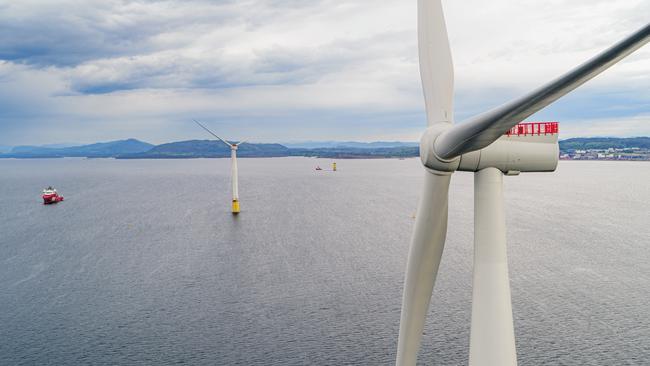Federal Labor expected to declare the final two offshore wind-farm regions
Federal Energy Minister Chris Bowen will on Wednesday reveal the last two regions for wind-powered electricity generation in Tasmania and WA.

Federal Energy Minister Chris Bowen will open the last two offshore regions for wind-powered electricity generation this year as Australia moves to accelerate the development of an industry seen as critical to the country’s chances of rapidly transitioning from fossil fuels.
In a bid to capitalise on growing interest, Mr Bowen will on Wednesday reveal the last two regions in Tasmania and Western Australia, which will be open for public consultation in November and December.
The federal government and states have placed offshore wind at the heart of plans to wean electricity generation off fossil fuels. The federal government last year proposed six regions as potentially suitable for offshore wind farms, and all but two have been formally approved or are open for public consultation.
“Twelve months ago we announced the first steps in creating a new renewable energy industry, with the announcement of six proposed regions with world-class offshore wind energy potential,” Mr Bowen will say in a speech in Melbourne.
“I have declared the first two zones: Gippsland and Hunter. We’ve begun consultation on the next two zones – Illawarra and the Southern Ocean region. And today, I’m pleased to confirm next steps on the two outstanding zones. Firstly – the Bass Strait region, off the Tasmanian coast. Consultation for this region will start at the beginning of October. Secondly, the Perth/Bunbury region off the coast of WA. Consultation will begin towards the end of November.”
Mr Bowen will say the timetable could mean all six offshore regions are open for development by mid-2024, but he will caution that the schedule is dependent on the support of local communities.
Australian authorities are increasingly conscious of securing local community support for renewable energy developments, which have historically progressed before pockets of resistance have slowed progress.
The scheduled timetable will come as Labor looks to lock in interest from developers, which have shown great interest in Australia despite the appeal of other markets.
Victoria has emerged as the most attractive market, with nearly 30 developers seeking licences to develop projects.
Global heavyweights including the likes of Orsted (the world’s largest offshore wind developer), Shell and Norwegian giant Equinor are battling it out with local giants such as Origin Energy, Macquarie and AGL Energy for licences in Gippsland, but only a handful are expected to be offered. With many developers poised to miss out, alternative plans and marketplaces are being considered.
Some developers could opt to buy into existing projects that have secured a licence, but others are pushing ahead with plans to move into one or more of the other Australian offshore wind regions.
While the other regions may not be as attractive as Gippsland – which has existing infrastructure, major demand centres and shallow ocean floors that allow for fixed turbines – interest is growing in the other five jurisdictions.
Tasmania has significant wind resources but the region appears dependent on the development of undersea cables to carry cheap renewable energy to the mainland.
However, the state warned earlier this month that the cost of Marinus Link undersea power cable project had ballooned.
WA is increasingly attractive as it has abundant wind resources and shallow ocean floors, but it doesn’t have the demand of NSW or Victoria.
However, industry sources said the region was drawing attention from developers.




To join the conversation, please log in. Don't have an account? Register
Join the conversation, you are commenting as Logout